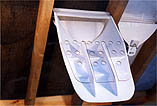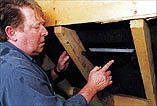![]()
Tel: +44 (0) 1202 979912


| lapVent |
| Illustrated Outline |
| Product Summary |
| Product Overview |
| Millennium Products Award |
| Mechanical Extraction |
| Fitting Instructions |
| Ordering & Contact Details |
| Discussion Forum |
Design Council
Millennium Products Award
Originally publishd by the Design Council.
 Dorset Master Craftsman Bryan Rowbotham has
developed an invisible vent for pitched roofs that aims to solve a major conservation
problem. Having worked in the roofing industry for forty years, Bryan was becoming
frustrated by the fact that many listed buildings were being left to rot under stifling
conditions, or aesthetically ruined by ugly ventilators. He faced an uphill struggle to
get his product to market because of its extremely innovative nature, but its worth is now
being recognised and it's set to make a commanding impact on the European roofing scene.
Dorset Master Craftsman Bryan Rowbotham has
developed an invisible vent for pitched roofs that aims to solve a major conservation
problem. Having worked in the roofing industry for forty years, Bryan was becoming
frustrated by the fact that many listed buildings were being left to rot under stifling
conditions, or aesthetically ruined by ugly ventilators. He faced an uphill struggle to
get his product to market because of its extremely innovative nature, but its worth is now
being recognised and it's set to make a commanding impact on the European roofing scene.
Inspiration
 Why did
you decide to develop the lapVent system?
Why did
you decide to develop the lapVent system?
Apart from wanting the wherewithal to publish a sorely needed comprehensive book on slate, stone and clay roofing, it was a result of my sheer frustration at what was happening to certain skills within the roofing profession. Essential crafts are being undermined by, amongst other things, the modern use of underfelt which not only chokes a roof but also acts as a safety net for poor handiwork. The main conservation bodies recognise the problem and are desperate for a solution to wet/dry rot, etc., and they know these ills can only be cured by positive ventilation. There was a massive gap in the market, basically, and this was an idea I knew could meet demand. It was a viable plan because it really improves the way otherwise sound traditional roofs are being maintained against unnecessary deterioration.
Implementation
 Did
prototype testing help in the development of lapVent?
Did
prototype testing help in the development of lapVent?
I did some prototype testing because of new research findings from the Building Research Establishment, but the outcome only confirmed what I had already known. I am proficient in laying most types of roof and with this wide knowledge and experience I knew what the problem was and what was required - so the original design features have remained constant.
Did you experience any difficulties during the development of this system?
Many, including having to design and make the manufacturing tool. Another considerable challenge was having to transfer my ideas into a realistic commercial mode for mass production. Nonetheless, it was something I took pride in and, after coming up with a gem of a solution, I can say with all honesty that I did yell, "Eureka!" in the bath one evening. The main problem I faced was ignorance, especially from those in the industry who suppose they are expert. A lot of manufacturers were frightened of taking risks by taking on something that was so different, preferring to stick with their old techniques despite the drawbacks - one delegation only came to Bournemouth for an ice cream on the beach. I have experienced too many people who talk big but act little.
How did you overcome this problem?
I knew that I had to get out there and do for myself what others had failed to do. I found it very unfortunate that the local agencies couldn't find a manufacturer nearby or help in any other way. So it was either fight or fail. I had far too much regard for what I had to offer so submission wasn't considered. If you are working on a shoestring, my particular product (although a relatively simple concept) is not easy to mass produce so it had to be virtually hand made in the early days. Eventually, with the help of the Teesside Tertiary Colleges' Plastics Centre in Middlesborough, I got involved with a company in County Durham, which wasn't perfect because of the distance, but it was all I had. Fortunately, I have recently found a very promising factory near Winchester, which is somewhat closer to home.
Impact
What are the main benefits of your system?
Although my invention was originally designed to eliminate venting difficulties within the conservation industry, it can also be used with modern roofing materials. It ventilates the internal voids of a roof by drawing air, quite naturally, through regular gaps between free-laid tiles, slates, etc., and with the shortage of expertise in this field (a dire problem), it doesn't require skilled workers to install it. The unit is fitted in minutes between two rafters at any overlapping runs of underlay, without major structural alterations or harmful breaching of insulating membranes - both acts can weaken the fabric of a building. Harsh weather conditions are managed by integral self-draining storm baffles which eliminate the 'flower pot; effect of stagnant water and dirt. Defusers dampen stiff breezes and negative wind loads immediately close off a self righting valve. By design, the filtered airflow is distributed upwards around the adjustable flap which radiates circulation over a wide area for greater effect - this aspect of the design was developed to meet current UK/Euro Building Regulations for roof ventilation, providing 20,0002mm free vent area. Alternatively, special fittings will connect ducting to specific locations in a building for the induction/exhaust venting of internal rooms, i.e., bathroom, bedroom, etc. If you like the whole unit can even be removed for dusting!
What lessons have you learned during the innovation process?
'Nix Illegitimi Carborundum' although poor man's Latin, this is a maxim I learnt long ago in the armed forces and it has proved to be appropriate. Loosely translated it means, 'don't let the b*****ds grind you down'. To start with, most lone innovators are bound for an awesome ordeal because those who hold sway seem to think little of unaffiliated pioneers - until they succeed. Nonetheless, take into account the fact that you are probably treading all over some one else's patch/ego, and you'll understand all the better. If the thing is a specialised product, you have to categorically prove its viability yourself and if it detracts from the norm you must go out on a limb to push it. But don't forget people cannot read what is so clear in your own head. Always explain things with graphic simplicity because people wont normally go out of their way to understand you, they'll just nod knowingly. Be wary of "big bad wolves". It's better to use friends and acquaintances as sounding boards rather than opportunists ' its your baby, you look after it! Those that should know better often don't, and those that think they know better are in the wrong job, so follow your nose.
Originally publishd by the Design Council.


© Copyright BNR, 2005. All rights
reserved.
Designed by Ayrmer Software.
